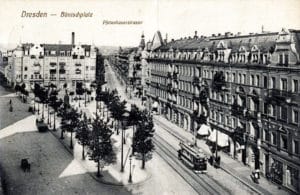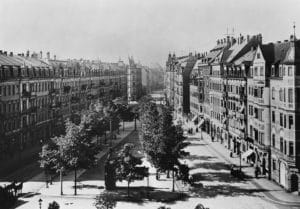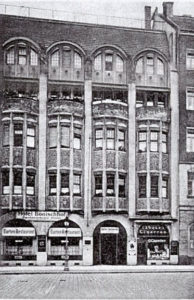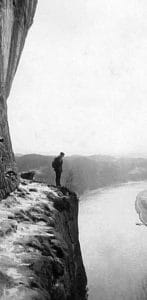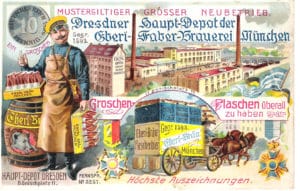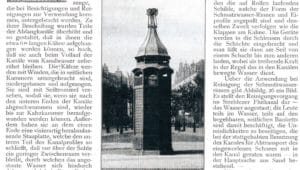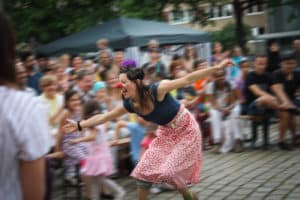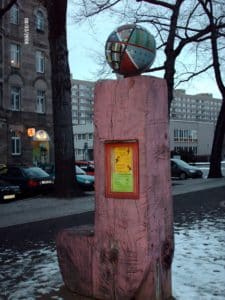This site is available in multiple languages: Deutsch, Русский, عربي.
From Thomas-Müntzer-Platz, walk down Florian-Geyer-Straße until you reach Pfeifferhannsstraße. Take a quick left in front of the shopping center, onto what was once Blumenstraße. There you will find location 8 of the historical walking tour: Bönischplatz.
Before 1945: Bönisch, beer and Bastei
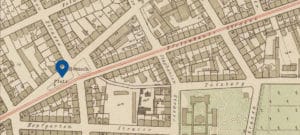
Site of Bönischplatz
In 1897, Pfotenhauerstraße was straightened and elongated until the intersection of Elisenstraße. This led to the formation of an open space: Bönischplatz. Bönischplatz got its name from Dresden mayor, city councillor and jurist, Karl Friedrich Emil Bönisch (1832–1894), who also lived in the immediate area. As a member of the 2nd council division, he was responsible for—among other things—the city hospital and the public hospital (now DRK Pflege- und Seniorenheim Clara Zetkin on Pfotenhauerstraße). The urban-oriented grid of Johannstadt, with streets laid across one another at sharp angles, resulted in a series of triangular open spaces, each of them covered in grass and completely surrounded by residential buildings. Because of the war, Bönischplatz is the only such space that still survives to this day.
Find öore information on the history of Bönischplatzes here.
Tramway line 18—Saxony’s first electric rail—entered service in 1893, running down Pfotenhauerstraße to Blasewitz. A rarely used turning loop was located on Hertelstraße/Burckhardtstraße/Neubertstraße.

Right: Path of line 18 through Johannstadt, and the turning loop at Hertelstraße, on a city map from 1911. Source: SLUB Dresden / Deutsche Fotothek
Businesses at Bönischplatz
In 1905, the Hotel and Restaurant Quack opened at Bönischplatz 9. From 1908 to 1920, there was also a cinematographical theater (cinema) at that location. In 1922, restaurateur Emil Max Rahm (1872–1952) took over the restaurant and changed its name to Bönischhof. Rahm had previously worked in the Basteihotel and was the first man to climb the “Rahm-Hanke” below the Bastei in the Sächsische Schweiz.
In 1907, Munich brewery Eberlbräu—later Paulaner—relocated the headquarters of its main depot in Dresden from Holbeinstraße to Bönischplatz no. 11. On a space of 3,500 square meters there were residential and factory buildings, a boiler- and powerhouse, and a cooling room made from reinforced concrete. Six bottle-filling stations cleaned, filled and labeled 10,000 bottles in one 10-hour shift.
In 1932, Dresden’s first privately operated car parks were established in the interior courtyard of Bönischplatz 7, with a capacity of around 120 vehicles.
After 1945: Ashes, cigarettes, hustle and bustle
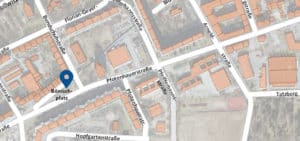
Below: Ruins at Bönischplatz, 1945. Photo: unknown, from the JohannstadtArchiv collection
Destruction and reconstruction
The bombings of February 1945 destroyed the entire south and northeast sides of the square. The only four original houses which remained were nos. 11-17. Apart from these houses, as of 2018, five of the trees planted back in 1879 are still alive and well.
Reconstruction of Bönischplatz began in 1970, with a ten-story apartment building on the south side. A high-rise was built on Bönischplatz (now Pfotenhauerstraße 5) in 1973: the first 15-story building in Johannstadt’s new construction program. And the former east side of Bönischplatz, east of Bundschuhstraße, was turned into a grassy lawn. As such, the only part of the square still visible today is the sharply-angled west section. In 1982, buildings were erected at Bönischplatz 5, 7 and 9 as apprentice residences for the collective combine BMK Energie und Kohle. Construction on the “Güntzareal” on the southwest side of Bönischplatz began in 2016.
Find more information on the history of Bönischplatzes here.
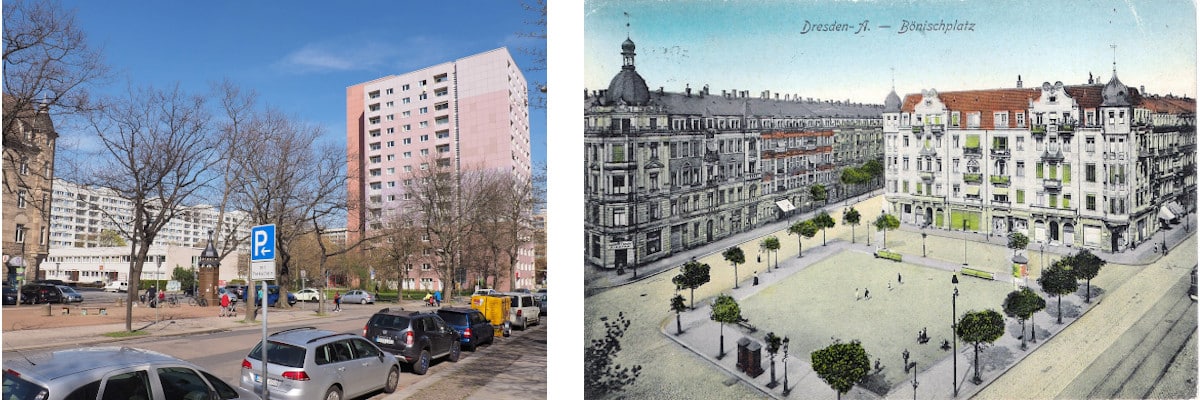
Right: same vantage point, before 1945. Photo: unknown, from the JohannStadtArchiv collection
Before their destruction, the impressive head houses stood on the exact same spot as the high-rise.
A lively space
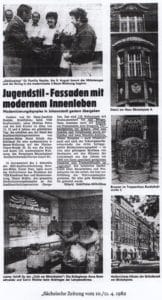
In GDR times, Bönischplatz continued to play host to diverse businesses. Among the numerous resident establishments were a repair workshop, hair salon, pharmacy, shoe store, produce shop, tobacconist’s, optician, artist studio, the Café am Bönischplatz and a paper recycling collection center. From 1997 to 2003, Werner Ehrlich ran a local store at Bönischplatz that enriched Johannstadt with a series of cultural activities. Preliminary beautification efforts were made in 2003, during which, among other things, new benches and Andreas Rode and Thomas Wieuduwilt’s wood and ceramic sculpture (which points to the Johannstadt cultural center) were installed. The statue still stands today. As a result of intense public involvement, a fundamental redesigning of the square will take place in 2020, to be better able to make use of the vibrant local space, e.g., for the Bönischplatzfest which has been held yearly since 2015.
|
|
Text: Matthias Erfurth, Matthias Kunert, Henning Seidler
Editorial deadline: March 2021

